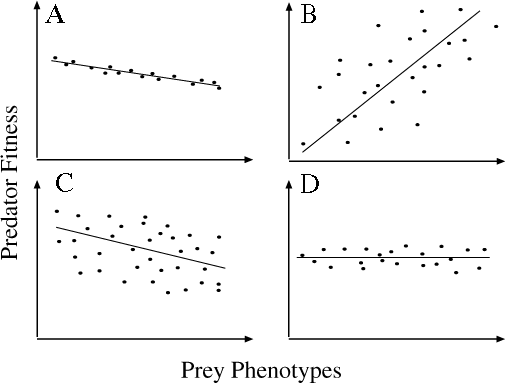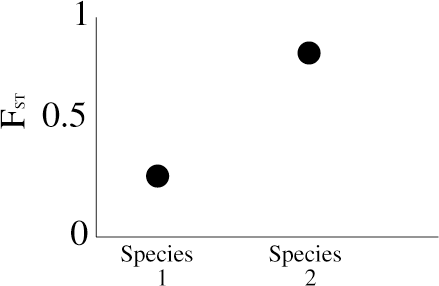Fall 2000 Midterm
In the left column below is a species, subject, or author from the papers in the reader. In the right column is a list of topics relevant to evolutionary biology. Link the left column with the MOST DIRECTLY RELEVANT AND SPECIFIC topic from right column by writing the appropriate letters in the blanks. (NOTE: the right column has more topics than the left; some topics will not be used, and none is used twice.) (20 points)
|
Species, Subject or Author |
Evolutionary Biology Topics |
|
|
1. |
Chronicle vs. Narrative |
A. Cline |
|
2. |
Isolation by Distance |
B. Evolution |
|
3. |
Sea Urchin Population Structure |
C. Life-Dinner Principle |
|
4. |
Population Growth in Elephants |
D. Macroevolution |
|
5. |
Guppies in Trinidad |
F. Arms Race |
|
6. |
Dangerous Prey |
G. Speciation |
|
7. |
Crayfish in the Ozarks |
H. On the Origin of Species |
|
8. |
Drosophila Wing Size |
I. Hox Gene Evolution |
|
9. |
European Oaks |
J. Life History Evolution |
|
10. |
Cloudogram |
K. MorphologyÕ PerformanceÕ Fitness |
|
L. Tree Thinking |
||
|
M. Phylogenetic Diversity |
||
|
N. Molecular Clock |
||
|
O. Alfred Russell Wallace |
||
|
P. log M (or, log Nm) |
||
|
Q. Gene Tree/Species Tree |
||
|
R. FST |
||
|
S. Hybridization |
11.) Below is a "containing tree" or a species phylogeny (Maddison, 1997 from the reader). Draw within it a gene tree showing a deep coalescence event. (6 points)
| A | B | C | D |

Below are covariance relationships like those seen in Brodie and Brodie (1999), whereby prey phenotype is regressed against predator fitness. Use these graphs to answer questions 12 to 14. The questions are phrased using the language of the Brodie and Brodie (1999) article.

12.) Which covariance relationship between prey phenotype and predator fitness is highly predictable yet of minor consequence? (2 points)
13.) Which covariance relationship between prey phenotype and predator fitness suggests no relationship between prey phenotype and predator fitness? (2 points)
14.) Which covariance relationship between prey phenotype and predator fitness is of highest consequence? (2 points)
Below is a simple graph illustrating the FST values calculated for two different species. Use it to answer questions 15 to 17.

15.) If gene flow impedes local adaptation, which species might you expect to be more locally adapted (assume both species have the same Ne and are in genetic equilibrium)? (4 points)
16.) If species 1 & 2 have the same census population size and the same proportion of migrants among subpopulations (m), how could they differ in FST? Provide two reasons. (6 points)
17.) Say you are a conservation biologist in charge of ensuring the survival of species 1. Roads and condos have split the species into isolated five populations, between which there is no migration. You want the individual populations to adapt to local conditions without the homogenizing influence of gene flow. However, you also want to maintain genetic diversity within the populations (ie: protect them from drift). Based on the simple theory presented in lecture, how many animals do you move between populations (and how often)? (6 points)
18.) Why are directed mutation and/or adaptive mutation considered to be "evolutionary heresies". (6 points)
19.) In general, cladists dislike reproductive compatibility as the criterion for species delimitation. Considering cladistic methodology, state why in one sentence. (6 points)
20.) Name 3 potential units of evolution. For each proposed unit, state the criteria that determine whether or not it can be considered a unit. Finally, indicate how they are hierarchically related, and state which unit you think is the most important and why. (15 points)
21.) Why is correlational selection viewed as more realistic than other modes of selection? (6 points)
22.) We measure the effects of natural selection by relative fitness, meaning that some kinds of organism in a population leave more offspring than other kinds. Why? Isn't it circular to say that the kinds that leave more offspring are the kinds that have left more offspring? Give some examples of what else we need to know to present an evolutionary explanation. (10 points)
23.) Give one "positive" and one "negative" explanation for the maintenance of sex in a population of diploid organisms. (10 points)
24.) In the diagram below, W denotes the fitness surface and the lower panel describes the current frequency distribution of a trait in a population. In the lower panel, draw a distribution of the trait following a period of sustained directional selection. (5 points)

Trait à